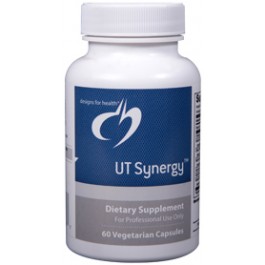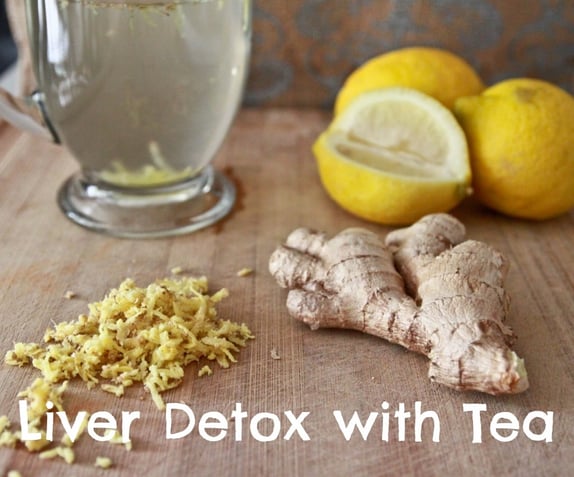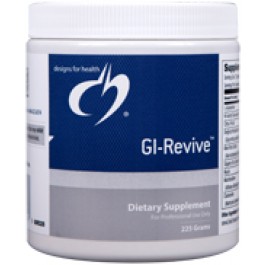
Quick Overview
UT Synergy™ features UTIRose™, a patented, exciting and unique compound designed specifically to support the health of the urinary tract.* UTIRose™ is a...
By Gene Bruno, MS, MHS, RH(AHG)

In her 1962 groundbreaking book Silent Spring, Rachel Carson wrote: “For the first time in the history of the world every human being is now subjected to contact with dangerous chemicals, from the moment of conception until death.” Of course humans have always been exposed to potentially harmful chemicals from plants and other sources, but Rachel Carson’s point is well taken. Modern living exposes all of us to an unprecedented number of chemicals on a daily basis. This includes environmental toxins such as heavy metals, pesticides, industrial compounds and chemical byproducts, medications, cosmetic additives, inorganic chemicals, etc. These chemical substances which are foreign to the biological system are referred to as “xenobiotics.”
The good news is that the body was designed to detoxify and excrete xenobiotics. The bad news is our bodies may not always be equipped to handle the volume of modern environmental pollutants and toxic substances. This problem may be exacerbated by the fact that the refining of many of our foodstuffs has caused them to provide considerably less of the nutrients that are essential to the detoxification process.1 2
The ramifications of toxic overload can vary from one individual to another. One possible ramification is multiple chemical sensitivities (MCS). MCS is a condition in which a person experiences various symptoms in response to being exposed to certain types of chemicals, primarily (but not limited to) those of petroleum and coal-tar derivation. The possible symptoms are many and may include headaches, fatigue, depression and an overall feeling of malaise and being sick. MCS seems to develop after consistent, long-term exposure to certain chemicals at home or in the workplace. Eventually, the person develops an intolerance to these chemicals, and starts suffering from MCS. For many MCS people, a sensitivity reaction will occur when exposed to even minute amounts of the offending chemicals which, in turn, can lead to severe symptoms characteristic of the MCS condition. 3
Of course, an individual may suffer from toxic overload without having full-blown MCS. In fact, the most common symptom of toxic overload is probably fatigue. Other common symptoms include headache, muscle and joint pain, irritability, depression, mental confusion, gastrointestinal and/or cardiovascular irregularities, flu-like symptoms or allergic reactions including hives, stuffy or runny nose, sneezing and coughing.4 5
Furthermore, some researchers have suggested that toxic overload may contribute to autoimmune diseases including inflammatory and rheumatoid arthritis6 7 , and neurological diseases such as Alzheimer's and Parkinson’s.8
The question of how to deal with toxic overload has a multi-part answer which includes adapting to a healthier diet and reducing exposure to xenobiotics. The books Multiple Chemical Sensitivity by Gibson (2000, New Harbinger Publications, Inc.) and Staying Well in a Toxic World by Lawson (1993, The Nobel Press) provide good direction on how to do this. In addition there are four herbal teas which, if used correctly, may do much to help support and promote the body’s natural detoxification process. These teas include ginger root (rhizome), green tea, dandelion root and senna. Following is a discussion about the role that each of these herbal teas can play, including a subsequent explanation of how to use them as part of a detox program.
Healthy circulation is of vital importance to an effective detoxification process.9 The fundamental reason for this is that toxins and metabolic wastes are flushed out of tissues and into circulation so they can be detoxified. 10 If circulation is sluggish and toxins move more slowly through it, however, this may result in undesirable symptoms such as headache and fatigue.11
The root or rhizome (enlarged underground stem) of Ginger (Zingiber officinale) is an herbal medicine that is valuable for the treatment of multiple problems, especially nausea. In fact, ginger has been reported to be effective in treating the nausea of seasickness, morning sickness and chemotherapy-induced nausea.12 Ginger is also a traditional carminative (gas relieving) herb,13 and has anti-inflammatory properties.14
For the purposes of detoxification, ginger is valuable since it promotes circulation, and has long been used for this purpose in Traditional Chinese Medicine. In fact, the most famous traditional medicinal practice of ginger is to promote the blood circulation for removing blood stasis and the mechanism is related to anti-platelet aggregation activity. In addition, ginger has a stimulatory action on heart muscle promoting circulation throughout the body. That increased circulation is thought to stimulate cellular metabolic activity. 15 16
Water soluble toxins can pass through our bodies unchanged and be eliminated in the stool, sweat or urine. Fat soluble toxins, however, cannot be excreted without undergoing metabolic transformation (detoxification) in the liver so that they can become water soluble. Liver cells have sophisticated mechanisms to break down toxic substances. These include both endogenous (produced by the body) and exogenous (obtained from the environment; i.e., xenobiotics) substances. Every drug, chemical, pesticide and hormone, is broken down or metabolized via detoxification pathways in the liver called “phase 1” and “phase 2.” 17 18 19 During phase 1, a “functional group” is removed from the toxic molecule, 20 21 and during phase 2 a water-soluble substance is coupled (attaching) or conjugated to the toxin. This makes the toxic molecule more water soluble and therefore less toxic. If the molecule is large, it is then excreted via the bile. Otherwise, it is excreted in the urine.22 23
Green, Oolong and black tea are all made from the leaves of the same plant species, Camellia sinensis. Green tea, the world’s second most popular beverage after water, is perhaps best known for its antioxidant and thermogenic properties. It is the polyphenols in Green tea, specifically the catechin polyphenols, which gives it biological and medicinal qualities.24
In fact, green tea polyphenols increase both phase 1 and phase 2 activities.25 Research shows that green tea may have liver protective properties.26 27 28 29 In addition, green tea has been shown to block chromosomal (DNA) damage from chemicals in cigarette smoke.30 Perhaps not surprisingly, green tea polyphenols are associated with a reduced risk of certain cancers in humans.31 Other research has also shown an anticancer effect from these polyphenols32, including an inhibition of metastasis in skin cancer cells.33 In short, the use of green tea helps improve phase 1 and 2 liver detoxification pathways.
Bile is a digestive aid for fats, produced by the liver and transported to the gallbladder where it is concentrated. It then passes through the common bile duct into the intestines where it helps digest fat.34 From the standpoint of detoxification, bile also has a function as previously stated: it serves as a vehicle for disposing of toxic molecules that are too large for disposal via urine.35 36 Essentially, those toxins just hitch a ride until they reach the intestines where they can ultimately be excreted.
Dandelion root (Taraxacum officinale) is a traditionally used liver herb that has been shown to help stimulate bile production and promote its flow.37 38 This supports the aforementioned detoxification process via the bile duct, promoting the elimination of wastes.39 In fact, Germany and other official European health agencies have approved the use of Dandelion root for disturbances in bile flow, and restoration of hepatic and biliary function. 40
It is well understood that waste is excreted from the intestines or, more specifically, the colon. During this process, bile that was secreted into the intestines is also excreted. Since that bile also contains some toxins that hitched a ride, it makes sense to make sure that it does not linger for too long in the gut, otherwise some of the toxins may be re-absorbed (clearly not a good thing). Constipation is the most obvious cause of waste lingering too long in the gut.
Senna leaf (Senna alexandrina ) is used extensively as a natural laxative, and has been shown in research to be effective for this purpose and for reducing constipation.41 42 43 44 Furthermore, when used appropriately on a short-term basis, senna has been shown to have a good safety profile.45 46 Sennosides, the active compounds in senna, are not absorbed, but instead are activated by bacterial enzymes in the colon.47 The result is that senna exerts its laxative effect by inducing fluid secretion, which increases colonic motility and colonic transit.48 In some instances, senna can cause abdominal pain and discomfort, cramps, and diarrhea; 49 50 so it is important not to exceed recommended doses.
Following are directions on how to use the herbal teas discussed in this article. First, make sure to use only organic teas since there is no point in adding additional toxins to the body in the form of pesticides that may have otherwise been sprayed on non-organic herbs. Second, assume that all of the teas should be made by adding one tea bag in a cup and adding 8 ounces of boiling water. The steep time and number of servings will differ depending upon the herb (as indicated below):
| Herb | Amount per tea bag |
Steep time (covered) |
Servings per day |
| Ginger root | 2 g | 10 min | 3 cups |
| Green tea | 2.13 g | 2 min | 3 cups |
| Dandelion root | 2 g | 12 min | 3 cups |
| Senna leaf | 1.9 g | 7 min | 1 cup |
As long as you steep the teas according to the times indicated, it is acceptable to consume them hot or cold (as iced tea). If you like, you can even mix the brewed ginger root, green tea and dandelion root (but not the senna) into a single beverage to make it easier to drink. In either case, it will probably be more convenient for you to brew all of the tea for the day in the morning, rather than having to brew it at three different times during the day (unless you’d like to do it that way). In the case of senna, it would be best to brew and consume the single serving in the evening before bedtime.
These herbal teas can be used to support detoxification for as little as two weeks or for up to one month. A twice annual “Spring and Fall cleaning” is recommended.
The herbal teas discussed in this article are certainly not the only natural products capable of supporting and facilitating the detoxification process. Compounds from citrus fruit and the Brassica or cruciferous group of vegetables (e.g., cabbage, Brussels sprouts, broccoli, etc.), as well as the dietary supplement alpha lipoic acid are some examples of other effective detoxifying agents.51 Nevertheless, the teas discussed in this article can be effective adjuncts to a program for detoxification.
In addition, it would make good sense to eat a diet high in fruit and vegetables, drink plenty of liquids and get at least 25 grams of fiber per day to support overall detoxification. Finally, it should be noted that the use of these teas as part of a detoxification program are meant to be used for general health and wellness purposes. If you have a serious health condition, you should seek the help of a healthcare professional who is knowledgeable about the process before starting a detoxification program.
Smart Supplementation™ is a free series of educational literature created by Huntington College of Health Sciences (HCHS) as a public service. Although copyrighted, it may be freely photocopied and distributed, but may not be altered in any way. Smart Supplementation™ is not intended as medical advice. For diagnosis and treatment of any medical condition, consult your physician.
1 Rogers SA. Chemical Sensitivity: Breaking the Paralyzing Paradigm. Internal Medicine World Report 1992; February 1- 14:15-16. 2 Rogers SA. Chemical Sensitivity: Breaking the Paralyzing Paradigm. Internal Medicine World Report 1992; March 15-31: 8- 31. 3 Lawson L. Staying Well in a Toxic World. Chicago: The Nobel Press, Inc.; 1993. 4 Lawson L. Staying Well in a Toxic World. Chicago: The Nobel Press, Inc.; 1993. 5 Gibson PR. Multiple Chemical Sensitivity. Oakland, California: New Harbinger Publications, Inc.; 2000. 6 Rooney PJ, Jenkins RT, Buchanan WW. A short review of the relationship between intestinal permeability and inflammatory joint disease. Clinical and Experimental Rheumatology 1990; 8(1):75-83. 7 Smith MD, Gibson RA, Brooks PM. Abnormal bowel permeability in ankylosing spondylitis and rheumatoid arthritis. Journal of Rheumatology 1985; 12(2):299-305. 8 Steventon, GB, Heafield MT, Sturman S, Waring RH, Williams AC. Xenobiotic metabolism in Alzheimer's disease. Neurology, 1990;40(7):1095-1098. 9 Hyman M. Systems Biology, Toxins, Obesity, and Functional Medicine. Proceedings from the 13th International Symposium of The Institute for Functional Medicine. 2006:S134-9. 10 Posadzki P, Smith TO, Lizis P. Lomi Lomi as a massage with movements: A conceptual synthesis? Altern Ther. 2009;15(6):44- 9. 11 Roundtree R. A functional approach to environmental toxins. Alternat Complement Ther. 2009;15(5):216-220. 12 Ernst E, Pittler MH. Efficacy of ginger for nausea and vomiting: a systematic review of randomized clinical trials. British journal of anaesthesia 2000; 84(3):367-71. 13 Blumenthal M, et al, (eds), The Complete German Commission E Monographs: Therapeutic Guide to Herbal Medicines. Austin: American Botanical Council and Boston: Integrative Medicine Communications;1998:425–26. 14 Srivastava KC, Mustafa T. Med Hypotheses. 1992;39(4):342-8. 15 Ghosh AK. Zingiber officinale: a natural gold. IJPBS. 2011;2(1):283-94. 16 Zadeh JB, Kor NM. Physiological and pharmaceutical effects of Ginger (Zingiber officinale Roscoe) as a valuable medicinal plant. Eur J Exp Biol. 2014;4(1):87-90. 17 Murray Rk, Granner DK, Mayes PA, Rodwell VW. Harper’s Biochemistry, 25th ed. New York: McGraw Hill; 1999:780-786. 18 Lüllmann H. Mohr K, Ziegler A, Bieger D. Color Atlas of Pharmacology, 2nd ed. Stuttgart: Thieme; 2000:32-39. 19 Roundtree R. The Use of Phytochemicals in the Biotransformation and Elimination of Environmental Toxins. IN Medicines from the Earth 2003: Official Proceedings. Brevard, North Carolina: Gaia Herbal Research Institute; 2003:115-128. 20 Murray Rk, Granner DK, Mayes PA, Rodwell VW. Harper’s Biochemistry, 25th ed. New York: McGraw Hill; 200:780-786. 21 Lüllmann H. Mohr K, Ziegler A, Bieger D. Color Atlas of Pharmacology, 2nd ed. Stuttgart: Thieme; 2000:32-39. 22 Murray Rk, Granner DK, Mayes PA, Rodwell VW. Harper’s Biochemistry, 25th ed. New York: McGraw Hill; 200:780-786. 23 Lüllmann H. Mohr K, Ziegler A, Bieger D. Color Atlas of Pharmacology, 2nd ed. Stuttgart: Thieme; 2000:32-39. 24 Graham HN. Green tea composition, consumption, and polyphenol chemistry. Prev Med 1992;21:334–50. 25 Stoner GD, Mukhtar H. Polyphenols as cancer chemopreventive agents. J Cell Biochem Suppl 1995; 22:169-80. 26 Presser A. Pharmacist’s Guide to Medicinal Herbs. Petaluma, California:Smart Publications; 2000. 27 Kuhn MA, Winston D. Herbal Therapy & Supplements: A Scientific & Traditional Approach. Philadelphia:Lippincott; 2000. 28 Mills S, Bone K. Principles and Practice of Phytotherapy: Edinburgh;Churchill Livingstone; 2000. 29 Blumenthal M, Goldberg A, Brinckmann J (eds). Herbal Medicine: Expanded Commission E Monographs: Newton, Massachusetts;Integrative Medicine Communications; 2000. 30 Shim JS, Kang MH, Kim YH, Roh JK, Roberts C, Lee IP. Chemopreventive effect of green tea (Camellia sinensis) amonth cigarette smokers. Cancer Epidemiol Biomakers Prev 1995; 4(4):387-391. 31 Mukhtar H, Ahmad N. Green tea in chemoprevention of cancer. Toxicol Sci 1999;52(2 Suppl):111–7. 32 Suganuma M, Okabe S, Sueoka N, et al. Green tea and cancer chemoprevention. Mutat Res 1999;428:339–44. 33 Menon LG, Kuttan R, Kuttan G. Anti-metastatic activity of curcumin and catechin. Cancer Lett 1999;141:159–65. 34 Afdhal NH. Diseases of the gallbladder and bile ducts. In: Goldman L, Schafer AI, eds. Cecil Medicine. 24th ed. Philadelphia, Pa: Saunders Elsevier; 2011. 35 Murray Rk, Granner DK, Mayes PA, Rodwell VW. Harper’s Biochemistry, 25th ed. New York: McGraw Hill; 2000:780-786. 36 Lüllmann H. Mohr K, Ziegler A, Bieger D. Color Atlas of Pharmacology, 2nd ed. Stuttgart: Thieme; 2000:32-39. 37 Vogel G. Natural substances with effects on the liver. In: Wagner H, Wolff P (eds). New Natural Products and Plant Drugs with Pharmacological, Biological or Therapeutic Activity. Heidelberg: Springer-Verlag; 1977. 38 Tierra M. International Journal of Alternative and Complementary Medicine. 1997; February:23-25. 39 Salmond S. Australian Journal of Medical Herbalism. 1997;9(1):14-18. 40 Blumenthal M, Goldberg A, Brinckman J (eds). Herbal Medicine: Expanded Commission E Monographs. Newton, Massachusetts: Integrative Medicine Communications; 2000:78-83. 41 Godding EW. Laxatives and the special role of senna. Pharmacology 1988;36:230-6. 42 Ramesh PR, Kumar KS, Rajagopal MR, et al. Managing morphine-induced constipation: a controlled comparison of an Ayurvedic formulation and senna. J Pain Symptom Manage 1998;16:240-4. 43 Shelton MG. Standardized senna in the management of constipation in the puerperium: A clinical trial. S Afr Med J 1980;57:78-80. 44 MacLennan WJ, Pooler AFWM. A comparison of sodium picosulphate ("Laxoberal") with standardised senna ("Senokot") in geriatric patients. Curr Med Res Opin. 1974;2:641-7. 45 Godding EW. Laxatives and the special role of senna. Pharmacology 1988;36:230-6. 46 Arezzo A. Prospective randomized trial comparing bowel cleaning preparations for colonoscopy. Surg Laparosc Endosc Percutan Tech. 2000;10:215-7. 47 Godding EW. Laxatives and the special role of senna. Pharmacology 1988;36:230-6. 48 Ewe K, Ueberschaer B, Press AG. Influence of senna, fibre, and fibre + senna on colonic transit in loperamide-induced constipation. Pharmacology 1993;47:242-8. 49 Langmead L, Rampton DS. Review article: herbal treatment in gastrointestinal and liver disease--benefits and dangers. Aliment Pharmacol Ther 2001;15:1239-52. 50 Sondheimer JM, Gervaise EP. Lubricant versus laxative in the treatment of chronic functional constipation of children: a comparative study. J Pediatr Gastroenterol Nutr 1982;1:223-6. 51 Roundtree R. The Use of Phytochemicals in the Biotransformation and Elimination of Environmental Toxins. IN Medicines from the Earth 2003: Official Proceedings. Brevard, North Carolina: Gaia Herbal Research Institute; 2003:115-128.

UT Synergy™ features UTIRose™, a patented, exciting and unique compound designed specifically to support the health of the urinary tract.* UTIRose™ is a...

GI Revive™ offers comprehensive support for optimum gastrointestinal health and function. The lining of the gut must have proper permeability and...